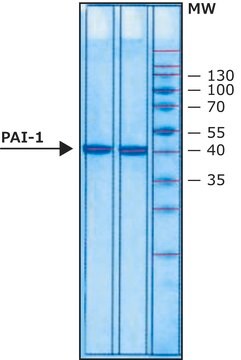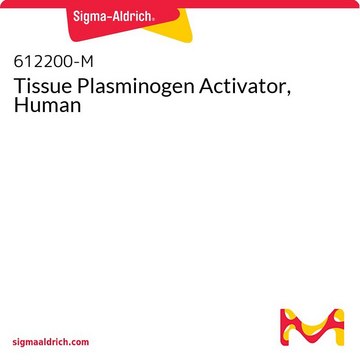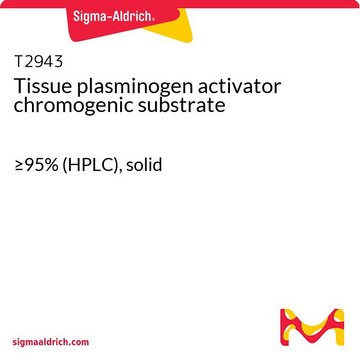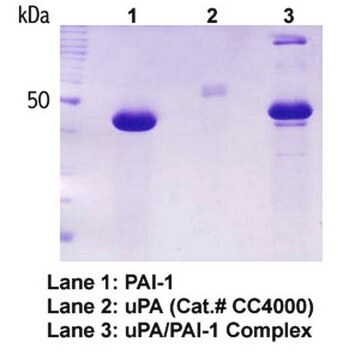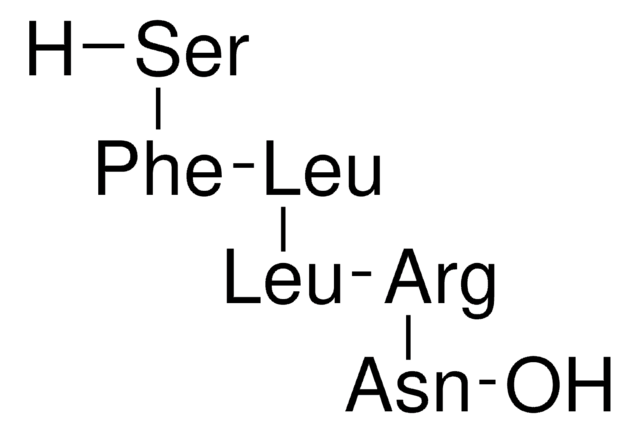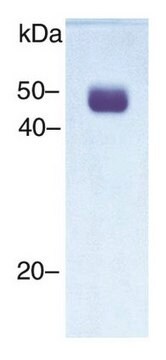528205
Plasminogen Activator Inhibitor-1, Human, Recombinant
The Plasminogen Activator Inhibitor-1, Human, Recombinant controls the biological activity of Plasminogen Activator. This small molecule/inhibitor is primarily used for Protease Inhibitors applications.
Sinônimo(s):
PAI-1
Faça loginpara ver os preços organizacionais e de contrato
About This Item
Código UNSPSC:
12352200
NACRES:
NA.77
Produtos recomendados
Nível de qualidade
Ensaio
≥98% (SDS-PAGE)
Formulário
liquid
fabricante/nome comercial
Calbiochem®
condição de armazenamento
OK to freeze
avoid repeated freeze/thaw cycles
Condições de expedição
wet ice
temperatura de armazenamento
−70°C
Descrição geral
PAI-1 is the primary inhibitor of both tissue plasminogen activator (tPA) and urokinase (uPA). PAI-1 can exist either in an active inhibitory conformation or in an inactive or latent conformation. This highly purified preparation has not been exposed to denaturing conditions and has been chromatographically purified of latent material. PAI-1 is a marker for acute myocardial infarction and several thrombolytic disorders. Protects platelets against the inhibitory effects of plasma. Reported to be an important prognostic factor in breast cancer patients. PAI-1 is highly stable when stored at or below pH 6.6.
Primary inhibitor of both tissue plasminogen activator (tPA) and urokinase (uPA). PAI-1 is synthesized by vascular epithelium and hepatocytes. Used as a marker for acute myocardial infarction and in the diagnosis of several thrombolytic disorders. Protects platelets against the inhibitory effects of plasma. Shown to have a role complimentary to that of α2-anti-plasmin. Elevated levels are found in subjects with accelerated coronary artery disease. PP1 activity may limit the extent of metastasis, since uPA activity is a major contributory factor promoting dissolution of tumor matrix and basement membrane. May serve as an independent and strong prognosticator in breast cancer patients. Patients having elevated levels of PAI-1 in their primary tumors are more prone to relapse. Can exist either in an active inhibitory conformation or in an inactive or latent conformation. This highly purified preparation has not been exposed to denaturing conditions and has been chromatographically purified free of the inactive material.
Ações bioquímicas/fisiológicas
Cell permeable: no
Primary Target
Tissue plasminogen activator (tPA) and urokinase (uPA)
Tissue plasminogen activator (tPA) and urokinase (uPA)
Product does not compete with ATP.
Reversible: no
Advertência
Toxicity: Standard Handling (A)
forma física
In 150 mM NaCl, 50 mM sodium phosphate buffer, 1 mM EDTA, pH 6.6.
Reconstituição
Following initial thaw, aliquot and freeze (-70°C).
Outras notas
Vaughan, D.E., et al. 1995. J. Clin. Invest. 95, 995.
Dimitri, G., et al. 1993. Boll. Chim. Farmaceutico 132, 272.
Janicke, F., et al. 1993. Breast Cancer Res. Treatment 24, 195.
Klasser, K.J., et al. 1993. Coron. Artery Dis. 4, 713.
Robbie, L.A., et al. 1993. Thromb. Hemost.70, 307.
Lawrence, D., et al. 1989. Eur. J. Biochem.186, 523.
Collen, D. and Lijnen, H.R. 1987. In The Molecular Basis of Blood Diseases (Stamatoyannopoulus, G., et al. Eds.) W.B. Saunders
Ginsberg, D., et al. 1986. J. Clin. Invest.78, 1673.
Vassalli, J.D., et al. 1985. J. Cell Biol.100, 86.
Dimitri, G., et al. 1993. Boll. Chim. Farmaceutico 132, 272.
Janicke, F., et al. 1993. Breast Cancer Res. Treatment 24, 195.
Klasser, K.J., et al. 1993. Coron. Artery Dis. 4, 713.
Robbie, L.A., et al. 1993. Thromb. Hemost.70, 307.
Lawrence, D., et al. 1989. Eur. J. Biochem.186, 523.
Collen, D. and Lijnen, H.R. 1987. In The Molecular Basis of Blood Diseases (Stamatoyannopoulus, G., et al. Eds.) W.B. Saunders
Ginsberg, D., et al. 1986. J. Clin. Invest.78, 1673.
Vassalli, J.D., et al. 1985. J. Cell Biol.100, 86.
Informações legais
CALBIOCHEM is a registered trademark of Merck KGaA, Darmstadt, Germany
Código de classe de armazenamento
10 - Combustible liquids
Classe de risco de água (WGK)
WGK 1
Ponto de fulgor (°F)
Not applicable
Ponto de fulgor (°C)
Not applicable
Certificados de análise (COA)
Busque Certificados de análise (COA) digitando o Número do Lote do produto. Os números de lote e remessa podem ser encontrados no rótulo de um produto após a palavra “Lot” ou “Batch”.
Já possui este produto?
Encontre a documentação dos produtos que você adquiriu recentemente na biblioteca de documentos.
Nossa equipe de cientistas tem experiência em todas as áreas de pesquisa, incluindo Life Sciences, ciência de materiais, síntese química, cromatografia, química analítica e muitas outras.
Entre em contato com a assistência técnica
